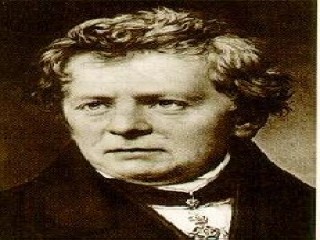
Georg Simon Ohm biography
Date of birth : 1789-03-16
Date of death : 1854-07-06
Birthplace : Erlangen, Bavaria
Nationality : German
Category : Science and Technology
Last modified : 2011-05-20
Credited as : Physicist, discoverer of Ohm Law,
The German physicist Georg Simon Ohm was the discoverer of the law, named for him, which states the exact relationship of potential and current in electric conduction.
Georg Ohm was born on March 16, 1789, in Erlangen, Bavaria, the eldest of seven children. His father, Johann Wolfgang Ohm, was a master mechanic and an avid reader of books on philosophy and mathematics. He cultivated the obvious mathematical talents of Georg and his younger brother, Martin, and the two soon gained the reputation of being the latter-day version of the famed Bernoulli brothers. Due to financial difficulties, Georg left the University of Erlangen in 1806 after three semesters. For the next year and a half he earned his living as private tutor in Gottstadt, Switzerland, but by 1809 he settled in Neuchatel to continue privately with his university studies. In 1811 he returned to Erlangen and obtained his doctorate. For the next three semesters Ohm taught mathematics at the University of Erlangen, but the meagerness of his income forced him to take the post of tutor at the realgymnasium in Bamberg.
Following the publication in 1817 of Ohm's first book, a textbook of geometry, he received an appointment as teacher of mathematics and physics at the Royal Prussian Konsistorium in Cologne. The well-equipped laboratory of the local Jesuit gymnasium was put at his disposal, and there he began his epoch-making investigations on the characteristics of electric circuits, a virtually unexplored field at that time.
In 1825 the Journal fur Chemie und Physik carried Ohm's first communication on the laws of the galvanic (electric) circuit, "Preliminary Notice on the Law according to Which Metals Conduct Contact-electricity." The paper gave an incorrect formula for what later became known as Ohm's law, but within a year Ohm corrected the mistake. The 1826 issue of the Journal carried Ohm's "Determination of the Law according to Which Metals Conduct Contact-electricity, Together with the Outlines of a Theory of the Voltaic Apparatus and of the Schweigger Multiplicator [Galvanoscope]." In the introductory part of the paper he noted that the new form of his law was not only in perfect agreement with all experiments but also embodied a unitary explanation of a broad range of phenomena. Consequently, he argued, his law or formula had to be a true law of nature.
These remarks of Ohm are important to note as they hold the key to some of the subsequent misunderstanding of his work. His experimental work was unimpeachable. His data fully justified his conclusion that the ratio of V (the change in electromotive force) and X (the electromotive force) was proportional to the ratio of h (the change in the length of the conducting wire) and x (the wire's original length), or V/X = h/ (b+x), where b is a constant.
Ohm was, however, determined to give the law a most general if not an a priori justification. In 1827 he published his most renowned work, The Galvanic Circuit Mathematically Treated. It contains the now familiar formula I = V/R written in the notation S = A/L, which is followed by the historic statement, "The magnitude of the current in a galvanic circuit is directly proportional to the sum of all tensions [potentials] and indirectly to the total reduced length of the circuit." By "reduced" he meant the appropriate resistances of all parts of the circuit.
Ohm's Galvanic Circuit was greeted with some appreciation but largely with indifference and with some hostility. He withdrew from the academic world for 6 years. In 1833 he became professor of physics at the Polytechnic School in Nuremberg. But the real turning point in his life came when the Royal Society of London awarded him the Copley Medal in 1841. Ohm dedicated to the Royal Society the first volume of his Contribution to Molecular Physics, a work in which he planned to elucidate the internal constitution of matter with the same success Isaac Newton had achieved in celestial dynamics.
Apart from the gigantic demands of the plan, Ohm's teaching duties stood in the way of its execution. In 1835 he assumed, in addition to his duties in Nuremberg, the chair of higher mathematics at the University of Erlangen. Shortly afterward, he became inspector of scientific education in the state of Bavaria. He achieved his lifelong dream, a position with a major university, in 1849 as professor at the University of Munich. He was working on the manuscript of his textbook on optics when he died on July 6, 1854.
















